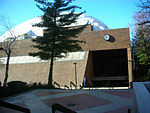Old Bergen Church
1660 establishments in North America1660 establishments in the Dutch EmpireChurches completed in 1841Churches in Hudson County, New JerseyChurches in Jersey City, New Jersey ... and 7 more
Churches on the National Register of Historic Places in New JerseyEstablishments in New NetherlandHistory of Jersey City, New JerseyNational Register of Historic Places in Hudson County, New JerseyNew Jersey Register of Historic PlacesPresbyterian churches in New JerseyReformed Church in America churches in New Jersey

The Old Bergen Church is a historic church congregation in Jersey City, Hudson County, New Jersey, United States. Established in 1660 in what was then the Dutch colony of New Netherland, it is the oldest continuous religious congregation in what is today the State of New Jersey. The congregation is jointly affiliated with the Reformed Church in America and the Presbyterian Church (USA). The church was added to the National Register of Historic Places on August 14, 1973. The original church building was constructed in 1680 and the current edifice was built in 1841.
Excerpt from the Wikipedia article Old Bergen Church (License: CC BY-SA 3.0, Authors, Images).Old Bergen Church
De Kalb Avenue, Jersey City
Geographical coordinates (GPS) Address Nearby Places Show on map
Geographical coordinates (GPS)
| Latitude | Longitude |
|---|---|
| N 40.726944444444 ° | E -74.069444444444 ° |
Address
St. Peter's University (Saint Peter's University)
De Kalb Avenue
07306 Jersey City
New Jersey, United States
Open on Google Maps






